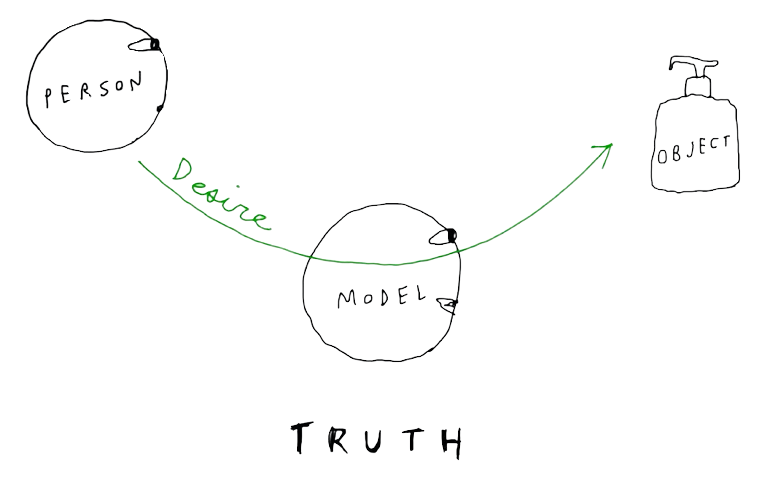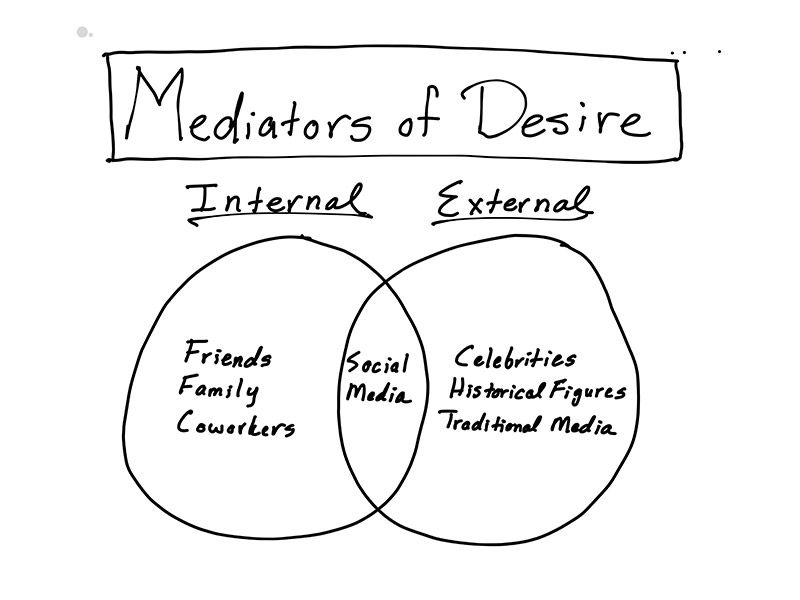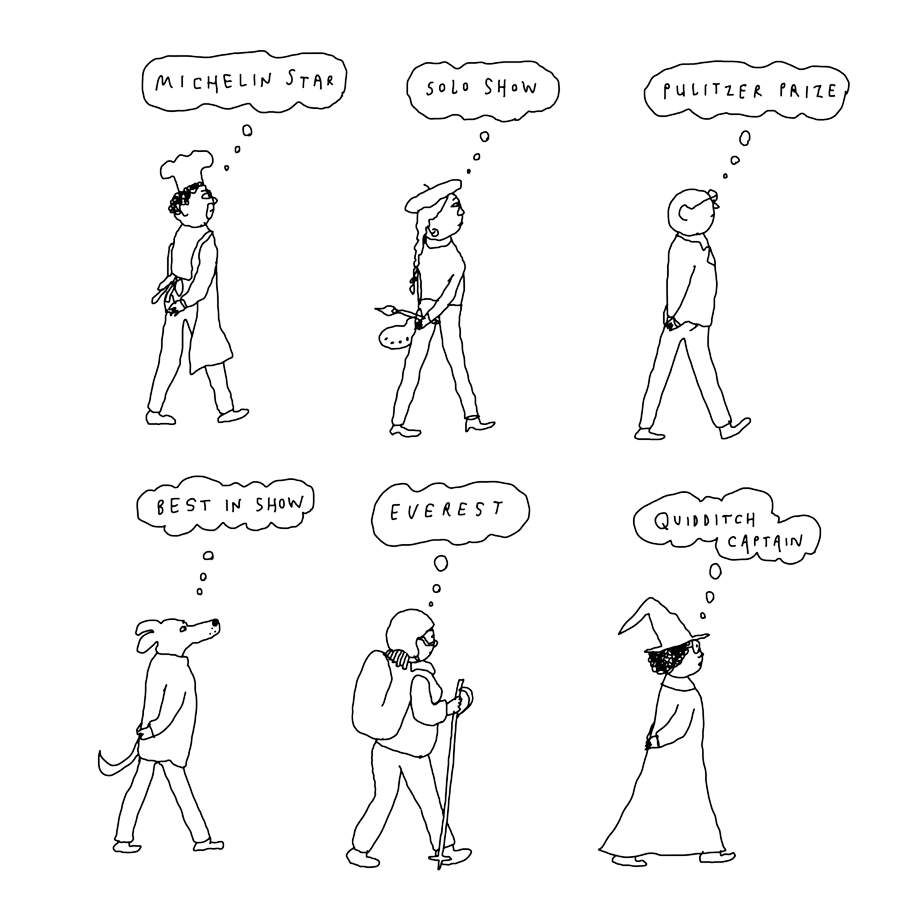Psyc Friday: Understanding Mimetic Desire

In our pursuit of happiness and fulfillment, we often assume that our desires are independent and autonomous. We believe that our choices are based on our own preferences and needs. However, according to the French social scientist René Girard, this assumption is a lie. Girard introduces the concept of "mimetic desire," which suggests that the desires of others heavily influence our desires. In this blog post, we will explore the idea of mimetic desire and how models shape our aspirations.
The Romantic Lie:
Girard refers to the belief that our desires are solely our own as "The Romantic Lie." We convince ourselves that we pursue certain things because they make sense to us or fulfill our authentic desires. However, beneath our conscious awareness, our desires are often influenced by the desires of others. We seldom question why we want the things we want.
The Influence of Models:

Models, whether they are individuals, groups, or even abstract concepts, play a significant role in shaping our desires and influencing our decisions. They act as navigational aids, helping us determine what we consider valuable and worth pursuing. Models serve as external markers, pointing us towards particular people, places, things, or lifestyles that we perceive as desirable. By observing and learning from these models, we hope to gain insights and qualities that we may feel are lacking in ourselves.
When we encounter models, we often look up to them, admiring their achievements or characteristics. We perceive them as exemplars of success, authority, or expertise in a certain field. We believe that by following their lead and emulating their actions, we can increase our chances of attaining similar levels of accomplishment or fulfillment.
For instance, in the realm of sports, young athletes often have role models, such as professional athletes or Olympic champions, whose skills and achievements they aspire to replicate. These models act as a source of inspiration and guidance, shaping the aspiring athletes' goals and motivating them to work hard to reach the same level of excellence.
Similarly, in the realm of personal development, individuals may look up to mentors or self-help gurus who have achieved personal and professional success. These models provide insights, strategies, and perspectives that can guide others in their own journeys towards growth and achievement.
Models can also extend to cultural or societal ideals. For example, certain body types, fashion trends, or lifestyle choices endorsed by influencers on social media can become models that shape people's desires and influence their behaviors. Individuals may strive to conform to these models, believing that embodying these ideals will bring them acceptance, validation, and a sense of belonging.
However, it is important to approach models critically and discerningly. While they can offer valuable guidance, blindly following models without considering our own values, aspirations, and unique circumstances can lead to unfulfillment or a sense of disconnection from our authentic selves. It is essential to strike a balance between drawing inspiration from models and maintaining individuality and self-awareness in our pursuit of desires.
Mediated Desire:
Mimetic desire operates through models who mediate desire to us. When we observe someone else desiring a particular object or experience, our perception of that object changes. For example, in a consignment store, a shirt on a rack becomes more desirable when our friend shows interest in it. Models transform objects through their desires, and we are drawn to those objects because of the desires of our models.
Two Types of Models:

When it comes to the influence of models on our desires, we can identify two distinct types of models, each having a different impact on our lives and aspirations. These models can be categorized as external mediators of desire and internal mediators of desire, and they play unique roles in shaping our perceptions and choices.
1. External Mediators of Desire:
External mediators of desire refer to models who exist in a realm that seems distant from our own lives. They can be celebrities, public figures, or individuals who have achieved a high level of social status, success, or fame. These models often occupy a position that feels unattainable to us, making it clear that we cannot directly compete with or replicate their circumstances.
For example, movie stars, renowned musicians, or globally recognized entrepreneurs can serve as external mediators of desire. We admire their talent, wealth, or influence from afar, recognizing that their achievements and lifestyles are beyond our immediate reach. While we may aspire to emulate certain aspects of their success or traits, we understand that our own paths and resources may differ significantly from theirs.
2. Internal Mediators of Desire:
On the other hand, internal mediators of desire are models who exist within our social world and have a more immediate influence on our lives. These models are often our peers, classmates, colleagues, or individuals who share similar circumstances and contexts as us. In settings where competition and comparison are prevalent, such as high school or college, our desires are significantly shaped by the influence of these internal models.
For instance, in a high school environment, students may be influenced by their classmates' achievements, popularity, or social standing. The desire to fit in, excel academically, or be recognized by their peers can be strongly influenced by the actions and successes of internal models within their immediate social circle.
Similarly, in a professional setting, colleagues who have achieved a certain level of success or recognition may become internal mediators of desire. We may observe their career advancements, skills, or accomplishments and find ourselves desiring similar achievements or professional growth.
The influence of internal mediators of desire is often more relatable and tangible compared to external mediators. Their proximity to our own lives and shared experiences can make their achievements feel within reach, serving as benchmarks or sources of inspiration for our own aspirations.
The Metaphysical Nature of Desire:

Desire is a complex phenomenon that extends beyond the simple pursuit of objects or goals. It encompasses a deeper longing for aspects such as identity, sense of being, and the desires of others. In our pursuit of desires, we often seek to acquire certain qualities, achievements, credentials, or social recognition that we associate with our desired state. Models, in this context, play a crucial role as they embody the qualities and attributes we perceive as lacking within ourselves, becoming a source of inspiration and aspiration.
The desire for Another's Desire:
One fascinating aspect of desire is the yearning for another's desire. This implies that our desires are not solely focused on the objects or experiences themselves, but also on the desire itself. We are attracted to the passion, motivation, and drive that others exhibit toward their own goals and aspirations. Witnessing someone's intense desire for something can ignite a similar longing within ourselves, leading us to desire not only the outcome but also the fervor and dedication associated with it.
For example, imagine a musician who is deeply passionate about their craft and pours their heart and soul into creating music. Observing their unwavering dedication and the joy they derive from their artistic expression can awaken a desire within us to experience that same level of passion and fulfillment in our own lives. In this case, the desire is not solely for the music itself, but also for the profound connection and sense of purpose that accompanies it.
Desire for a Certain Identity or Sense of Being:
Desire often extends beyond specific objects or achievements and encompasses a desire for a particular identity or sense of being. We associate certain qualities, traits, or lifestyles with our desires, perceiving them as integral components of our desired state of being. Models, who embody these qualities or possess the desired identity, become significant sources of inspiration and influence.
For instance, consider someone who aspires to be an influential leader in their field. They may look up to renowned figures who have demonstrated exceptional leadership qualities and have made a significant impact on their respective industries. The desire here is not solely for the achievements or status associated with leadership, but for the identity and sense of purpose that comes with it. Models, in this case, represent the embodiment of those desired qualities, serving as role models whose paths we aspire to emulate.
Association of Achievements, Credentials, or Social Recognition:
In the pursuit of our desires, we often associate specific achievements, credentials, or social recognition with the fulfillment of those desires. These external markers become intertwined with our desires, as they symbolize the validation, success, or progress we seek.
For example, someone aspiring to become a successful entrepreneur might associate the attainment of a prestigious business award or widespread recognition in their industry with the realization of their desires. The desire, in this case, is not solely for the award or recognition itself but for the validation it represents and the sense of accomplishment it brings.
Models, who possess the achievements, credentials, or social recognition we desire, become symbols of our aspirations. Their accomplishments serve as indicators of the path we believe will lead us closer to the fulfillment of our desires.
In summary, the metaphysical nature of desire goes beyond the mere pursuit of objects. It encompasses the desire for another's desire, the longing for a specific identity or sense of being, and the association of achievements, credentials, or social recognition with our desires. Models, as embodiments of the qualities and attributes we perceive as lacking within ourselves, play a pivotal role in shaping our aspirations and inspiring us to pursue our desired states of being.
The Influence of Social Media on Mimetic Desire:

In today's interconnected world, social media platforms have become powerful catalysts for shaping and influencing our mimetic desires. Social media provides a unique environment where models, desires, and aspirations are constantly displayed and shared. Here's how social media influences our mimetic desire:
Exposure to Idealized Representations:
Social media platforms are flooded with carefully curated content, showcasing idealized versions of people's lives, achievements, and possessions. We are exposed to a constant stream of images, videos, and stories that highlight the glamorous aspects of others' lives. These representations often trigger our mimetic desire by presenting a seemingly perfect and desirable existence that we strive to emulate.
For example, seeing influencers with luxurious lifestyles, exotic travel destinations, or fashionable wardrobes can evoke a desire within us to attain similar levels of success, material wealth, or social recognition. The desire is no longer solely for the inherent value of these possessions or experiences but for the perceived status and validation that comes with them.
Validation and Social Comparison:
Social media platforms thrive on the culture of likes, comments, and shares, which serve as forms of validation and social affirmation. The number of followers, engagement metrics, and popularity become metrics of social worth and desirability. As a result, we often find ourselves comparing our own lives, achievements, and appearance to those of others, leading to the development of mimetic desires.
For instance, witnessing others receive praise, admiration, or recognition for their accomplishments on social media can create a desire within us to garner similar attention and validation. We may start mimicking their behaviors, choices, or pursuits in the hopes of achieving comparable recognition or acceptance.
Influencer Culture:
Social media has given rise to a new breed of models known as influencers. These individuals have amassed significant followings and possess the power to shape trends, opinions, and desires. Influencers often showcase their lifestyles, endorse products, and share their experiences, cultivating a sense of admiration and aspiration among their followers.
For example, fitness influencers promoting a particular workout regimen or diet plan can create a mimetic desire among their audience to adopt similar fitness practices and achieve similar physical transformations. The desire here is not solely for improved health or well-being but also for the perceived attractiveness, confidence, and social acceptance associated with the desired physique.
FOMO and Fear of Missing Out:
Social media perpetuates a pervasive sense of FOMO (Fear of Missing Out), where we are constantly exposed to glimpses of others' exciting experiences, social gatherings, and adventures. This constant exposure can create a fear that we are missing out on something desirable or enjoyable, fueling our mimetic desires.
For instance, seeing friends or acquaintances attending exclusive events, parties, or vacations can generate a desire within us to be part of those experiences and share in the associated joy, excitement, or social connections.
Filter Bubbles and Echo Chambers:
Social media platforms often utilize algorithms that personalize our content feed based on our previous interactions, preferences, and online behavior. While this can enhance user experience, it can also create filter bubbles and echo chambers, limiting our exposure to diverse perspectives and models.
When our social media feeds primarily consist of content that aligns with our existing beliefs, interests, and desires, we may find ourselves trapped in a cycle of reinforced mimetic desires. This can narrow our worldview, limit our exploration of alternative aspirations, and further strengthen our desire to conform to certain models within our bubble.
In conclusion, social media platforms play a significant role in influencing our mimetic desires. Through exposure to idealized representations, validation and social comparison, influencer culture, FOMO, and the creation of filter bubbles, social media shapes our aspirations and fuels the desire to emulate certain models. It is important to maintain awareness and critical thinking while navigating social media to ensure that our mimetic desires align with our authentic values and aspirations.
Understanding mimetic desire provides insights into the complex nature of human desires. Our aspirations are not isolated but heavily influenced by the desires of others. Models play a significant role in shaping our desires externally and internally. By recognizing the power of mimetic desire, we can gain a better understanding of our own motivations and make more conscious choices.
Reflecting on Your Mimetic Desires:
To gain a better understanding of your own mimetic desires and where they come from, consider pondering the following questions:
- What are the models or influencers that have a significant impact on shaping your desires? Are they individuals in your immediate social circle or public figures you admire from a distance? How do these models represent qualities or achievements that you perceive as lacking in yourself?
- How does social media influence your mimetic desires? Take a moment to reflect on the content you consume and the emotions it evokes. Are there specific patterns or trends that consistently trigger your desires? How does the validation and comparison culture on social media affect your aspirations?
- Have you ever experienced FOMO (Fear of Missing Out) due to social media exposure? Reflect on instances where you felt a strong desire to be a part of a certain experience or possess a particular item because of what you saw on social media. How did that desire influence your behavior or decision-making?
- Consider the role of validation and social recognition in your mimetic desires. Are there certain achievements, credentials, or social status that you associate with your desires? How much importance do you place on external validation versus intrinsic satisfaction?
- Are there any filter bubbles or echo chambers that you find yourself in within the realm of social media? Reflect on the diversity of perspectives, models, and aspirations you are exposed to. Do you actively seek out alternative viewpoints or models that challenge your existing desires, or do you find yourself reinforcing your desires within a limited bubble?
By contemplating these questions, you can gain insights into your own mimetic desires, their origins, and the influences that shape them. Remember that self-awareness and conscious reflection are crucial in aligning your desires with your authentic values and aspirations, allowing you to navigate the world of models and influences with clarity and purpose.